#ground sloth
Explore tagged Tumblr posts
Text
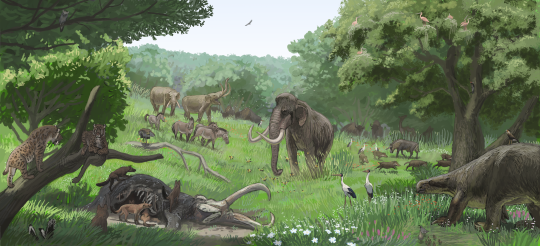
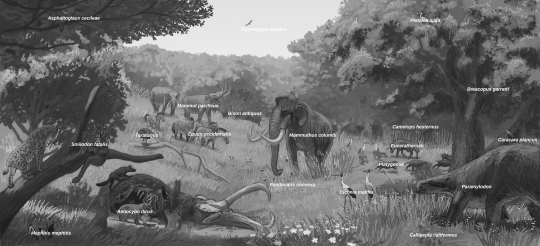
And here it is, the La Brea piece! All three groups of animals I'm not confident with (horses, cats, dogs), in one place! But I think it turned out all right in the end.
After some last touch ups I also added 2 more birds and flowers in the foreground. Big thank you to the devs of the game Ecos: La Brea, of which many joined to give feedback and to talk about their game that will let you play as an animal in and around the tar pits.
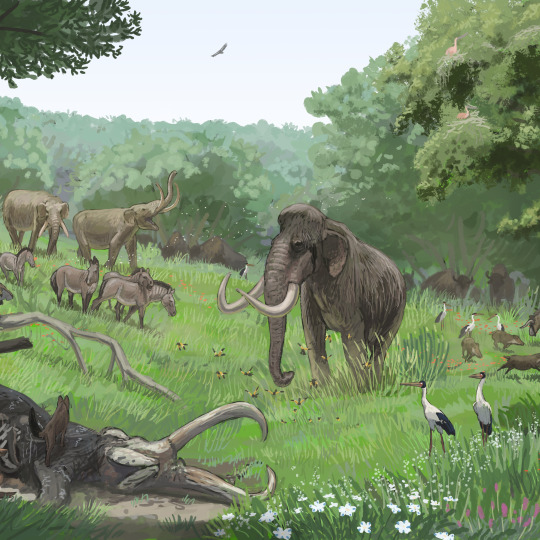
Speaking of the tar pits: I avoided them here very much on purpose. With the exception of the petroleum fly these animals did not LIVE in the tar pits and Pleistocene California wasn't always as dry as it is today or as it is often time portrayed. Especially after extensive rain, the hills and plains must have been full of herbs and flowers, attracting all sorts of megafauna. Check out the Ecos website if you want to learn more about these animals and the ecosystems they lived in.
#paleoart#sciart#paleostream#palaeoblr#pleistocene#mammoth#mastodon#smilodon#dire wolf#peccary#california#ground sloth
529 notes
·
View notes
Text

Party like a ground sloth, because it’s Fossil Friday! This image, snapped circa 1957 depicts giant sloths on display in the Museum. During the Pleistocene, a wide array of ground sloths lumbered across North and South America. Some, like the island-dwelling Megalocnus rodens, evolved to be long-distance swimmers. Others, like the mighty Megatherium, were among the largest land mammals to ever live. The biggest ground sloths could have weighed up to 8,800 lbs (4,000 kg)—the size of an elephant! Most of these mammals died out at the end of the Pleistocene. There is also evidence that ground sloths and early humans used the same caves, but not necessarily at the same time.
See giant ground sloths and more on the Museum's fourth floor! We're open daily from 10 am–5 pm. Plan your visit.
Photo: Image no. 324981 / © AMNH Library
#science#amnh#museum#fossil#nature#natural history#animals#paleontology#fact of the day#did you know#sloth#lestodon#megatherium#ground sloth#giant ground sloth#megafauna#fossil friday#natural history museum#museum of natural history
431 notes
·
View notes
Text

Ko-fi Creature Commission - Horseshoe Crab + Giant Ground Sloth
#shire draws#creature design#kofi#horseshoe crab#giant sloth#ground sloth#giant ground sloth#monster design#animal bingo
564 notes
·
View notes
Text

A ground sloth gal. Even though it’s probably a myth they helped disperse avocado seeds, they still look good with avocado greens!
68 notes
·
View notes
Text

To be honest, I'm more surprised that ground sloths are still around, or at least were in Saxton Hale's younger years. Legitimately got stunned for a few seconds because I didn't expect TF2 of all things to have a Megatherium.
25 notes
·
View notes
Text

Jeffersons Ground Sloth
#motherwilds#worldbuilding#webcomic#artists on tumblr#original character#nature#webtoon#illustration#digital art#ground sloth#sloth#paleontology#paleoart#paleomedia#prehistoric animals#paleo art
80 notes
·
View notes
Text
Crystal Palace Field Trip Part 3: Walking With Victorian Beasts
[Previously: the Jurassic and Cretaceous]
The final section of the Crystal Palace Dinosaur trail brings us to the Cenozoic, and a selection of ancient mammals.
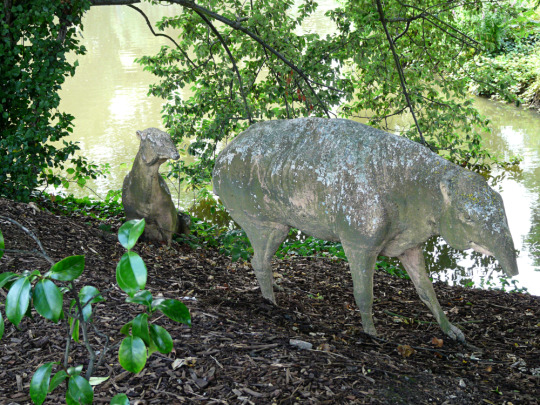
Image from 2009 by Loz Pycock (CC BY-SA 2.0)
Originally represented by three statues, there are two surviving originals of the Eocene-aged palaeotheres depicting Plagiolophus minor (the smaller sitting one) and Palaeotherium medium (the larger standing one).
The sitting palaeothere unfortunately lost its head sometime in the late 20th century, and the image above shows it with a modern fiberglass replacement. Then around 2014/2015 the new head was knocked off again, and has not yet been reattached – partly due to a recent discovery that it wasn't actually accurate to the sculpture's original design. Instead there are plans to eventually restore it with a much more faithful head.
These early odd-toed ungulates were already known from near-complete skeletons in the 1850s, and are depicted here as tapir-like animals with short trunks based on the scientific opinion of the time. We now think their heads would have looked more horse-like, without trunks, but otherwise they're not too far off modern reconstructions.
There was also something exciting nearby:
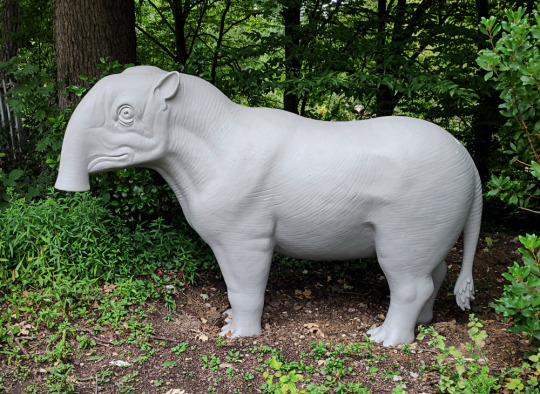
The recently-recreated Palaeotherium magnum!
This sculpture went missing sometime after the 1950s, and its existence was almost completely forgotten until archive images of it were discovered a few years ago. Funds were raised to create a replica as accurate to the original as possible, and in summer 2023 (just a month before the date of my visit) this larger palaeothere species finally rejoined its companions in the park.
Compared to the other palaeotheres this one is weird, though. Much chonkier, wrinkly, and with big eyes and an almost cartoonish tubular trunk. It seems to have taken a lot of anatomical inspiration from animals like rhinos and elephants, since in the mid-1800s odd-toed ungulates were grouped together with "pachyderms".
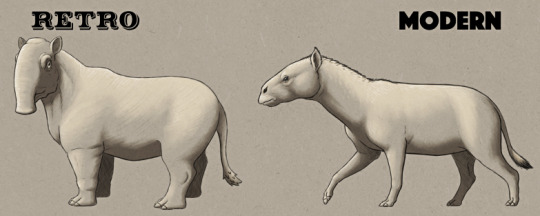
———
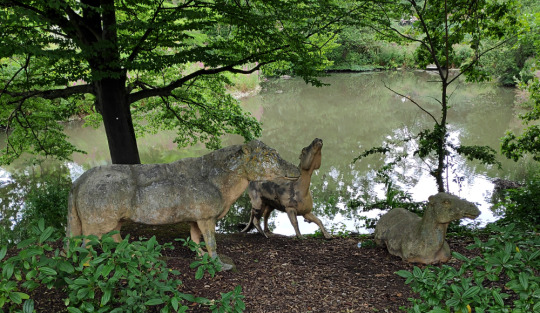
Next is Anoplotherium, an Eocene even-toed ungulate distantly related to modern camels.
(Apparently the sculpture closest to the water is a replica of a now-lost original, recreated from photo references in the same manner as the new Palaeotherium magnum. I can't find a definite reference for when this one was done, though – I'd guess probably during the last round of major renovations in the early 2000s, at the same time as the now-destroyed Jurassic pterosaur replicas?)
Anoplotherium commune is a rather obscure species today, but it was one of the first early Cenozoic fossil mammals to be recognized by science in the early 1800s. Depicted here as small camel-like animals, the three statues are positioned near the water's edge to reflect the Victorian idea that they were semi-aquatic based on their muscular tails.
Today we instead think these animals were fully terrestrial, using their tails to balance themselves while rearing up to reach higher vegetation. Their heads would also have looked a bit less camel-like, but otherwise the Crystal Palace trio are still really good representations.
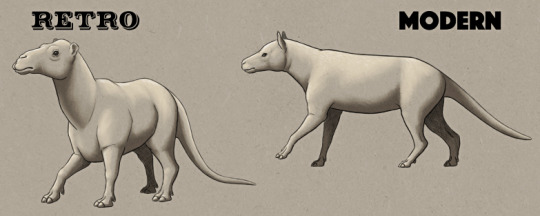
———
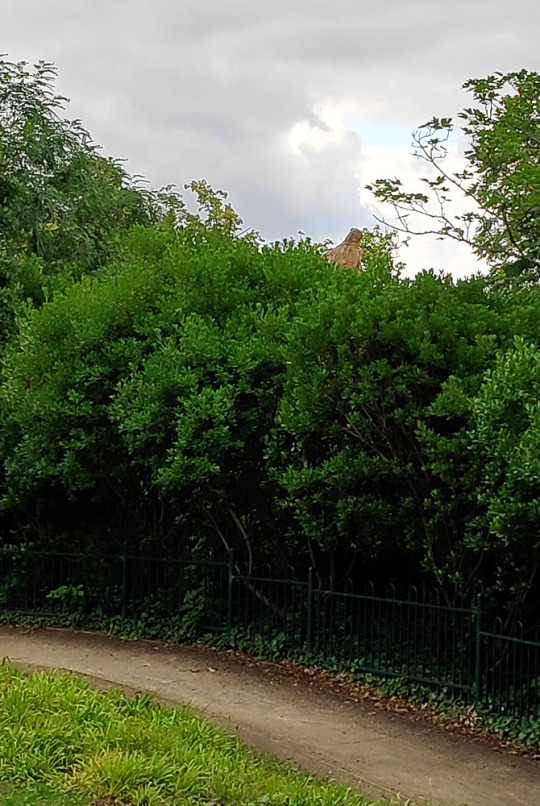
Next is a sculpture that's very easy to miss in the current overgrown state.
Who's that peeking over the bushes?
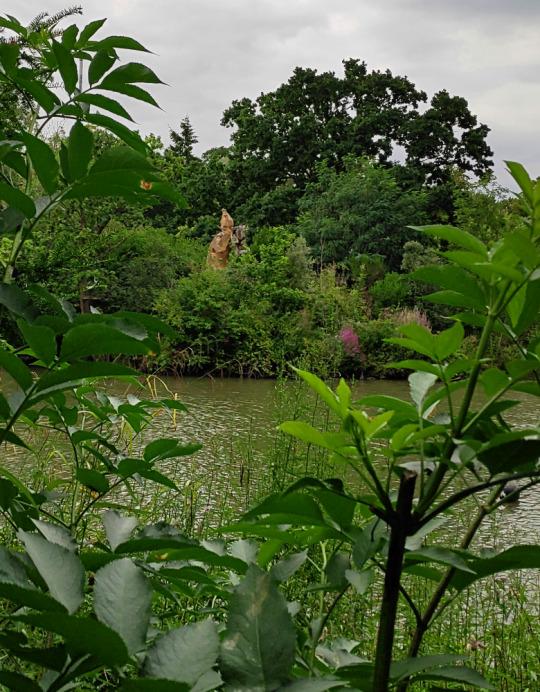
Going all the way around to the far side of the lake reveals a distant glimpse of the Pliocene-to-Holocene giant ground sloth Megatherium.

A better view of the Megatherium | "Tree Hugger" by Colin Smith (CC BY-SA 2.0)
Fossils of Megatherium americanum had been known since the late 1700s, but the 1854 Crystal Palace statue was still one of the first life reconstructions of this animal. Its anatomy is actually very close to our modern understanding, depicted with correctly inward-turned feet and sitting upright to feed on a tree with its tail acting as a "tripod".
However, we now know it didn't have a trunk-like nose, but instead probably had prehensile lips more like those of a modern black rhino.
Something weird also appears to have happened to the Crystal Palace Megatherium's hands. Early illustrations of the sculpture all consistently show it with the typical long claws of a sloth, but today it's missing its right hand and its left has only a strangely stumpy paw – suggesting that at some point in the intervening 170 years there was an unrecorded crude repair.
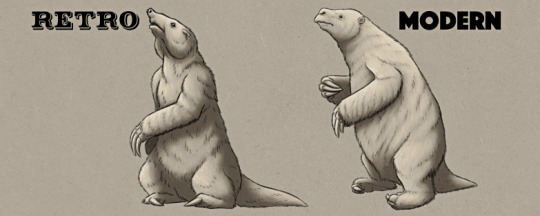
———

And finally we end the trail with three Megaloceros, the Pleistocene-to-Holocene "Irish Elk" that's actually neither exclusively Irish nor an elk.
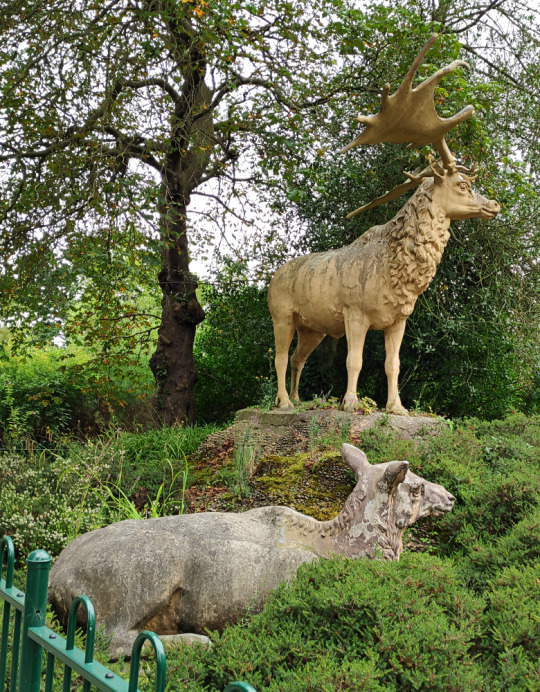
A closer look at the second stag and the doe.
There was originally a fourth giant deer sculpture in this herd, a second resting doe, but it was destroyed sometime during the mid-20th century. The stags also initially had real fossil antlers attached to their heads, but these were removed and replaced with less accurate versions at some point by the mid-20th century.
One of the stags' antlers suffered some damage in 2020, ending up drooping, and since then one antler has either fallen off or been removed.
In the 1850s Megaloceros giganteus was thought to be closely related to deer in the genus Cervus, and so the Crystal Palace reconstructions seem to be based on modern wapiti – specifically in their winter coats, fitting for ice age animals – since both the stags and the doe sport distinctive thick neck manes.
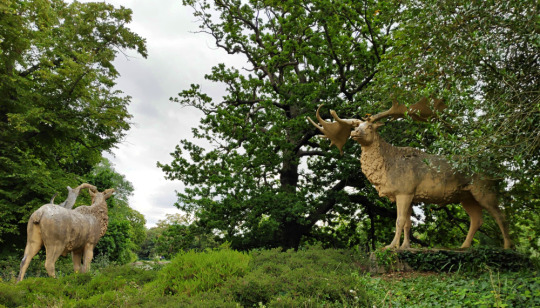
The stags from the other side.
We now know Megaloceros was actually much more closely related to modern fallow deer, and so probably resembled them more than wapiti. Cave art also shows that it had a hump on its shoulders, and even gives us an idea of what its coloration was.
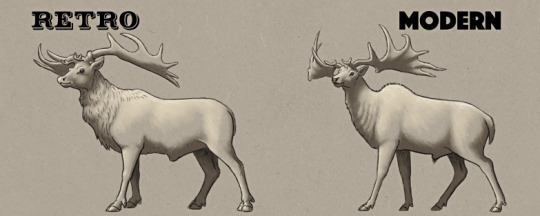
———
…But wait!
There's actually one more thing.
A small statue sitting on the far side of the deer herd, missing its ears, and seemingly representing a Megaloceros fawn.
Except it's actually something very different and very special.
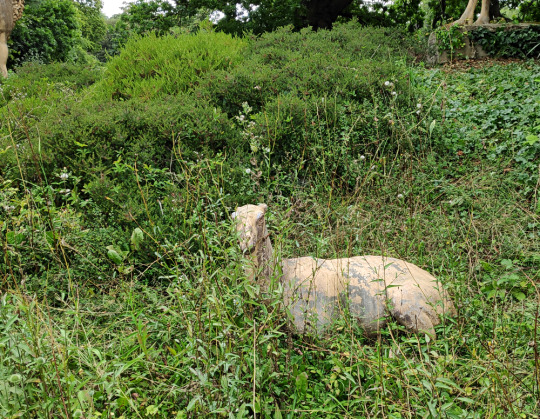
Ceci n'est pas un cerf.
Some recent investigation work revealed some surprising information about the Crystal Palace mammal statues – much like the nearly-forgotten large Palaeotherium, there was originally an entire group of four small Eocene-aged llama-like Xiphodon gracilis that had disappeared from living memory.
There was also no historic record of a fawn with the giant deer, but instead a suspiciously similar-looking sitting sculpture is illustrated among what we now known are the four missing Xiphodon in early records.
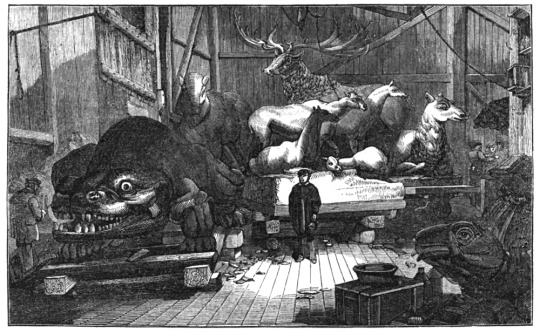
An 1853 illustration of the sculpture workshop. The four Xiphodon are shown in the center, directly in front of a Megaloceros stag and doe. (public domain)
Somewhere in the late 19th or early 20th century three of the Xiphodon must have been completely lost, and the remaining individual was misidentified as a fawn and placed with the giant deer herd.
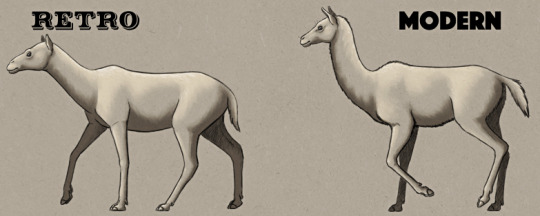
———
Rediscovering a whole extra species among the Crystal Palace statues is exciting, but it also demonstrates just how much of these sculptures' history has gone completely undocumented.
The mammal statues especially seem to have suffered the most out of the "Dinosaur Court", being often overlooked, neglected, disrespected (at one point the Megatherium was inside a goat pen in a petting zoo!), and subjected to cruder repairs. A total of five original statues are now known to be missing from this Cenozoic section – the original large Palaeotherium, the three other Xiphodon, and the second Megaloceros doe – compared to the two pterosaurs lost from the Mesozoic island.
Hopefully the excellent recreation of the lost Palaeotherium magnum is the start of a long overdue new lease of life and conservation attention for all of the Crystal Palace sculptures. It was disappointing seeing them all in such an overgrown state, and with signs of ongoing disrepair in places such as the plant growing out of the big ichthyosaur's back.
But there has been some resurgence of interest and public attention in the Crystal Palace sculptures over the last few years, so with any luck these historic pieces of early paleoart will survive on to their 200th anniversary and beyond, to keep on reminding us of where things began and how far our understanding of prehistoric life has since come.
#field trip!#crystal palace dinosaurs#retrosaurs#i love them your honor#crystal palace park#crystal palace#palaeotherium#anoplotherium#xiphodon#ceci n'est pas un cerf#megaloceros#ungulate#megatherium#ground sloth#mammal#paleontology#vintage paleoart#art#proper art post tomorrow#this took longer than expected#also apologies for my potato-quality camera#i'm an illustrator not a photographer
334 notes
·
View notes
Text





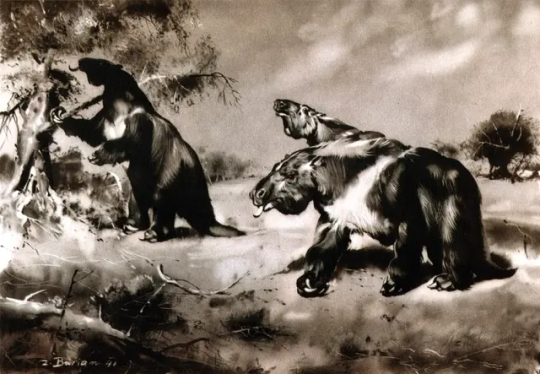




Illustrations by Zdenek Burian for the book Prehistoric Animals by Dr. Joseph Augusta. Jane Gaskell cited this book as a resource for the setting of her Atlan series.
#atlan#jane gaskell#zdenek burian#mammoth#dinosaur#terror bird#ground sloth#paleoart#diatryma#ichthyosaurus#megatherium#brontosaurus#neanderthal
17 notes
·
View notes
Text

Skeches of the North American animals that were part of the famous Pleistocene Megafauna, from left to right: Mammuthus columbi, Camelops hesternus, Bison antiquus, and Megalonyx jeffersoni
#paleoart#paleontology#pleistocenemegafauna#pleistocene#mammoths#mammal paleontology#mammal#mammoth#Columbian mammoth#bison#camel#megalonyx#ground sloth
62 notes
·
View notes
Text

A fossilized jaw of a ground sloth, possibly Thinobadistes segnis from Dixie County, Florida, United States. This species of Miocene aged xenarthran is one of the earliest occurrences of ground sloths in North America whose ancestors arrived on the continent before the land bridge that connected South America and North America.
#synapsid#mammal#fossils#paleontology#palaeontology#paleo#palaeo#thinobadistes#sloth#ground sloth#xenarthran#miocene#cenozoic#prehistoric#science#paleoblr#ティノバディステス#オオナマケモノ#ナマケモノ#化石#古生物学
9 notes
·
View notes
Text
Giant Ground Sloth 🦥💖
Two-toed Sloth 🦥💖
Three-toed Sloth 🦥💖
Sloths 💖🦥💖🦥💖🦥💖
Like if you agree 💕
Reblog if you agree 💞
#ghostie mumbles#sloth#giant ground sloth#two-toed sloth#three-toed sloth#2-toed sloth#3-toed sloth#ground sloth
34 notes
·
View notes
Text
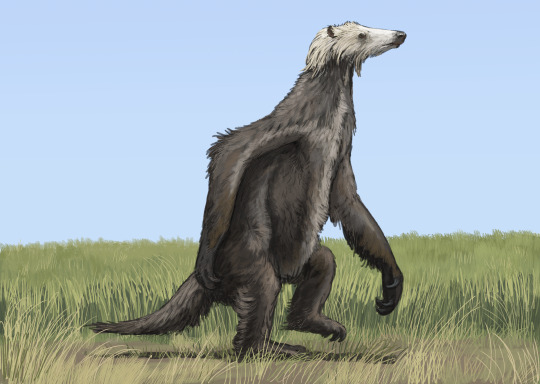
Did you know that ground sloth were able to walk bipedially? Well yes, they did, quite a bit actually when we look at the track record. Here it's Nothrotherium doing it.


653 notes
·
View notes
Text
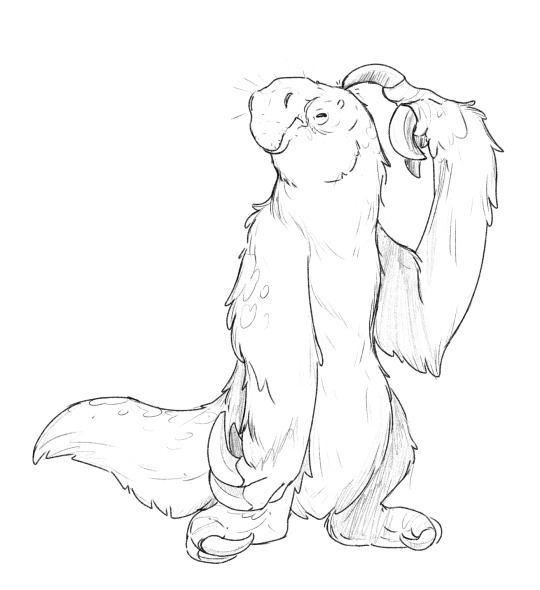
Behold a man (when he feels like it)
Megatherium
92 notes
·
View notes
Text
Cryptid of the Day!
THE YUKON BEAVER EATER: or as it was originally know as the saytoechin, is a Canadian cryptid with a multitude of sightings down on the west coast. Now, in my humble opinion, I humbly say this guy is underrated as fuck! Sure some people say he’s a lot like big foot, but c’mon! This guy is a blood thirsty ground sloth that could crush the skull of a grizzly bear with the sheer density of his ass!
The tea:
He’s known for snacking on beavers, like- all the time. I mean, saytoechin, his traditional name, literally translates to ‘beaver eater.’
His sightings were originally described as basically a fucked bear until the eyewitnesses were given a photo of the suspected culprit; the 10,000 year extinct ground sloth. From this day forward, most sources say he’s a super buff ground sloth, while some say he’s a giant cannibalistic beaver…. or a fucked up bear. Eye witness report: "The latest report was from Violet Johny, my husband’s sister, who was fishing with her husband and her mother at the head of Tatchun Lake 4 or 5 years ago. An animal came out of the woods, 8 or 9 feet high, bigger than a grizzly bear. It was a “saytoechin” and it was coming towards them. They panicked, fired a few shots over its head and finally managed to get the motor going and took off. There are other reports. There is also a report that a white man shot one in a small lake in that area. Beaver eaters are supposed to live in the mountainous area east of Frenchman Lake."- Dawn Charlie, 1990

22 notes
·
View notes
Text

It's been hard keeping this under wraps for a minute, haha. I'm doing a pin set with exclusive artwork! The Kickstarter begins next week, but you can follow it here right now!
#art#my art#enamel pins#sabertooth#elk#irish elk#mammoth#hyena#ground sloth#bone crushing dog#enteledon#hell pig#prehistoric#megafauna#poppies#saguaro#ceibo#iris#flowers#black#gold#accessories#kickstarter
142 notes
·
View notes
Text
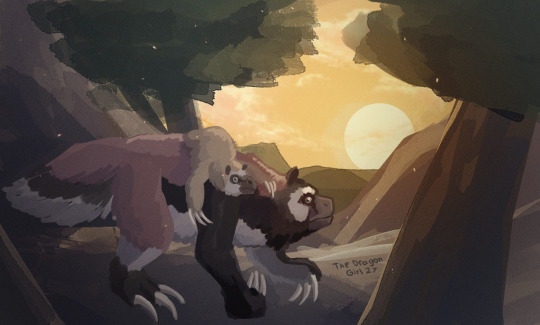
Also just realized i never posted this
Mother ground sloth carrying her child on her back.
#paleoart#cenozoic#ground sloth#Megatherium#mammal#sloth#i guess???#i love ground sloths so much wish modern sloths went this hard#i guess we have anteaters for that#also the colors on this were inspired by anteaters also the carrying young on her back is a behavior in anteaters and sloths#so i think its reasonable to believe ground sloths also did this#and more importantly its cute#also i have beef with the ice age sloth for gaslighting society into thinking anceint sloths werent cool#dragon draws creatures
27 notes
·
View notes